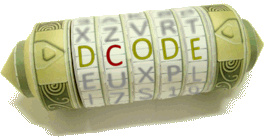Tool to search for prime numbers, such as the prime following a given number (next), or the nth prime number greater than a given number (Next Prime Function)
Next Prime Number - dCode
Tag(s) : Arithmetics
dCode is free and its tools are a valuable help in games, maths, geocaching, puzzles and problems to solve every day!
A suggestion ? a feedback ? a bug ? an idea ? Write to dCode!
Next Prime Number
Next Prime Number Search
Answers to Questions (FAQ)
What is the next prime number? (Definition)
For a given number $ N $, the next prime number is the smallest number strictly greater than $ N $ which is a prime number. As there are an infinity of prime numbers, this number always exists.
How to calculate the next prime number?
There is no formula on how to find the next prime number. dCode uses an algorithm that performs a probabilistic primality test (Miller-Rabin test) on each of the numbers greater than or equal to the number requested, then check it with a deterministic test.
Example: The first prime number following 1000 is 1009.
Example: The 10th prime number after 100 is 149 (so there are 9 prime numbers between 101 and 148)
The number must be a positive real number (the decimal numbers are accepted).
How to find smallest primes with n digits?
The first prime number following $ 10^{n-1} $ is a number with $ n $ digits which is the smallest n-digit prime number.
Example: 2, 11, 101, 1009, 10007, 100003, etc. here
What are twin primes numbers?
A prime number and the next prime number are said to be twins if their difference is 2.
Example: 11 and 13 are twin primes because 13-11 = 2.
Source code
dCode retains ownership of the "Next Prime Number" source code. Any algorithm for the "Next Prime Number" algorithm, applet or snippet or script (converter, solver, encryption / decryption, encoding / decoding, ciphering / deciphering, breaker, translator), or any "Next Prime Number" functions (calculate, convert, solve, decrypt / encrypt, decipher / cipher, decode / encode, translate) written in any informatic language (Python, Java, PHP, C#, Javascript, Matlab, etc.) or any database download or API access for "Next Prime Number" or any other element are not public (except explicit open source licence). Same with the download for offline use on PC, mobile, tablet, iPhone or Android app.
Reminder: dCode is an educational and teaching resource, accessible online for free and for everyone.
Cite dCode
The content of the page "Next Prime Number" and its results may be freely copied and reused, including for commercial purposes, provided that dCode.fr is cited as the source (Creative Commons CC-BY free distribution license).
Exporting the results is free and can be done simply by clicking on the export icons ⤓ (.csv or .txt format) or ⧉ (copy and paste).
To cite dCode.fr on another website, use the link:
In a scientific article or book, the recommended bibliographic citation is: Next Prime Number on dCode.fr [online website], retrieved on 2025-12-31,
